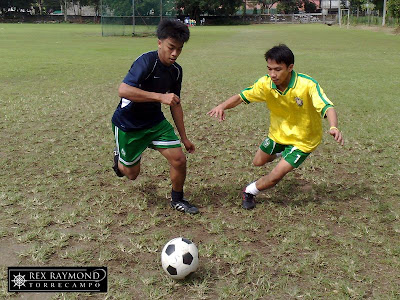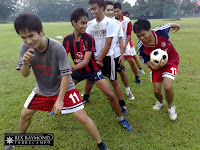Taking Injured Players to the Hospital
There were few things that I abhorred in coaching more than having to take a boy to the hospital for an injury. That said, the incidents were thankfully relatively few and far between.
Most of these were fairly innocuous: cuts that needed to be stitched up; or minor fractures that were not in any way life threatening.
There was this one fracture, though, when the moment the boy fell on the ground, I immediately knew it would be bad. The incident happened, if I am not mistaken, in 1998. We were doing shooting drills when one of our new sophomores was tackled by an older one and lost his balance. I was about 20 feet away; but even that far I heard the tell-tale cracking sound.
To this day, I can still vividly recall the blood draining from my face and a chill running up my spine the moment I heard the crack. Instinct just simply told me that it would be a bad one. When I approached the boy, there it was. The forearm was broken and one broken end of it was protruding through the boy’s skin. Thankfully, the bone did not pierce through the flesh and skin; else, I would have fainted. How so lacking in poise would that have been?
If I remember correctly, the boy’s parents were both abroad; and the lady who came to the hospital was a guardian or a relative rather than a parent. Our insurance protocols were not yet in place in those days; and so the family of the boy was expected to shoulder the initial hospital costs.
It was obvious that surgery was required to repair the fractured forearm. This was when it got complicated. The lady baulked when told by the resident doctor. It was obvious that cash was the problem; and I do not think there were many more moments in my life that I wished more than that particular one that I was a billionaire.
To make a long story short, the lady insisted on taking the boy home where, she said, she would be able to refer him to a doctor friend. What she was telling all of us, much as I wished that the boy – who was in obvious distress – would get treatment at the soonest possible time, was that the family would not be able to afford the services of the hospital we had taken the boy to.
As a footnote to this story, I later learned that the boy was not operated on until the next day. I shudder to even contemplate how intense the pain must have been overnight. The boy never returned to play for us again.
There was this other incident – which happened about a year earlier in 1997 – when the injury itself was innocuous; but the situation at the emergency room of the hospital where we rushed the boy was extremely agitating.
We were doing races; and the runner was supposed to tag the player next in line as the cue for the latter to start sprinting. The boys were always instructed to approach the line on the outside to avoid collisions; but it was not unusual for high school boys to not have their wits with them during training.
Indeed, there was one alarming collision; and a clash of heads at that. What is it about the clashing of heads that one head always comes off worse than the other? Well, this boy had a gaping cut just top of one eyebrow; and it obviously looked like it needed stitches.
It was while we were waiting for the x-ray results when the erstwhile quiet emergency room suddenly burst into activity. A jeepney filled with people sped into the parking lot; and a man who we would later find out was shot several times was hurriedly brought into the room.
It was surreal – doctors and nurses frantically attempting to revive the man with at least half a dozen people from the jeepney surrounding the bed. The doctors were barking orders; the nurses followed their instructions; and the orderlies rushed to and from the room in barely controlled mayhem.
The player I was with was sitting on a chair a few feet from where all the action was happening. I turned him around so he would not have to see what was going on; even if he could hear everything including the wails of the old women who had come along with the group.
Minutes passed before one of the hospital personnel realized that it was best to usher everyone out of the emergency room and draw the curtains around the bed. At last, thankfully, the scene was covered.
Before long, the man was proclaimed dead; and naturally the wailing started all over again. Apparently, the doctor on duty, in trying to stop the bleeding, had tried to extract the bullets from the man. How would I even know this? Because soon one of the orderlies placed a small plastic bottle on the table right next to my player – and inside it were three or four bullets.
I do not think the orderly realized how inappropriate putting that plastic bottle was beside my player. The boy had had more than enough excitement for just one afternoon. After what seemed like an eternity, the boy’s eyebrow was finally sewn up and we took him home in the school vehicle.
The only really severe case that I can remember from an official match was when we were playing in the RIFA in 1989 at the La Salle Greenhills field. At this time, six-studded football shoes were still very much in fashion.
At any rate, one of my fullbacks slid into a tackle, caught one of the opponent’s studs just to the side of the patella and there was this big round hole on his knee and blood was gushing out of it. It took all my powers to not die on the spot when I saw that hole. Goodness! It was almost as big as a coin!
Thankfully, one of the host school’s clinic personnel volunteered to take the boy to the hospital; while I stayed with the team as the game was still ongoing. They sewed him up and, thankfully, he looked none the worse for wear when he came back. When we brought him home, he told his father this silly little story about falling on a rock just so he would not get trouble from him. He was back training with us the following week.
-------------------------------------------------------------------------------------------
If you enjoyed this article, please click the Like button or share it freely on social media. It helps to pay this site's domain name and maintenance costs.












Post a Comment